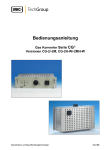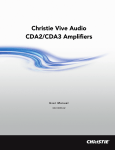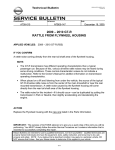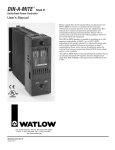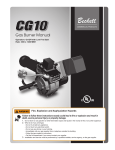Download Pro-Max CG10 Operating instructions
Transcript
Operating instructions Gas converter series CG, Version CG-10. (Units after December 2012) 9-2.0-ME US M&C Products Analysis Technology -2- Table of content 1 Electrical standards 3 2 Safety instructions 3 3 Warranty 4 Used terms and signal indications 4 5 Introduction 5 6 Application 5 6.1 (Figures 1 & 2 ) Functional diagram, sample tpath details 6 7. Working principle of the conversion 7 .4 7.1 Selection of the appropriate catalyst temperature ............................................................................. 7 8. Technical data table 9. Description 8 9 10. Receipt and storage of goods 10 11. Installation instructions 11 12. Supply connections 11 12.1 Hose/tube connections ..................................................................................................................... 12 12.2 Electrical connections .................................................................................................................... 12 13. Initial use 13 14. Taking the converter out of operation 13 15. Determining the catalyst service life 14 15.1. Figures 4-6, Catalyst life as a funtion of concentrations 14-15 16.1 Replacing the catalyst cartridge ..................................................................................................... 16 16.2 Replacing the O-ring seals .............................................................................................................. 17 16.3 Checking for gas tightness .............................................................................................................. 18 17. Troubleshooting 18 Appendix ......................................................................................................................................... 20 19 App 1 Electrical Diagram ....................................................................................................................... 21 App 2 PID temperature controller program and settings ..................................................................... 22 This instruction manual is subject to technical modifications. It is the operators responsibility to insure proper training, safety and operating precautions are observed when using electrical gas analysis equipment. ©11/2000 M&C Products Analysentechnik GmbH. Reproduction of this document is not allowed without permission from M&C CG® is a registered trade mark. . M&C Products Analysis Technology 9-2.0-MEUS -3- 1. Electrical standards The electrical standard corresponds to the safety regulations concerning the European standard EN 61010 and DIN 57721 for testing the voltage of heater elements. 2. Safety instructions Please note the following basic safety procedures when using this equipment: • Read these operating instructions carefully before start-up and use of the equipment. The information and warnings given in these operating instructions must be heeded. • Attention must be paid to the requirements of IEC 364 (DIN VDE 0100) when setting high-power electrical units with nominal voltages of up to 1000V, together with the associated standards and stipulations. • Work on electrical equipment is only to be carried out by trained specialists as per the regulations currently in force. • Check the details on the type plate to ensure that the equipment is connected up to the correct mains voltage. • Protection against touching dangerously high electrical voltages. Before opening the equipment, it must be switched and hold no voltages. This also applies to any external control circuits that are connected. • The equipment is only to be set within the permitted range of temperatures and pressures. • The CG-10 is packaged in an enclosed purgeable instrument case, directly suitable for installation in most General Purpose classified areas. Operation in hazardous atmospheres may require case purging, pressure interlocks, additional enclosures or other protective devices. It is the responsibility of the operator to insure compliance with additional requirements for service in hazardous atmospheres. • Installation, maintenance, monitoring and any repairs may only be done by authorized personnel with respect to the relevant stipulations. M&C Products Analysis Technology 9-2.0-MEUS -4- 3. Warranty If the equipment fails, please contact M&C directly or else go through your M&C authorized dealer. We offer a one year warranty as of the day of delivery as per our normal terms and conditions of sale, and assuming technically correct operation of the unit. Consumables are hereby excluded. The terms of the warranty cover repair at the factory at no cost or the replacement at no cost of the equipment free ex user location. Reshipments must be send in a sufficient and proper protective packaging. 4. Used terms and signal indication These are persons with necessary qualification, who are familiar with installation, use and maintenance of the product. SKILLED STAFF The signals are used according to DIN 4844 and EU Recommendation 91/C53/06. These note important information about the product or parts of the instruction manual which require user’s attention. 9-2.0-ME US M&C Products Analysis Technology - 55. Introduction In combustion processes NOx emissions are frequently present as a mixture of NO and NO2. Regulatory reporting and process control systems often require the measurement of total NOx. Consequently, analytical measurement systems typically require sensitivity to both species. Many analytical systems rely on the chemiluminescent measurement principle. This principal determines NO concentration by accurately measuring the amount of light produced by reaction of NO with ozone to produce NO2. Other analytical methods may also have sensitivity only to the NO portion of NOx as well. As a consequence, these types of measurements require that NO2 is converted back to NO prior to sample entry into the measurement cell. Fortunately for most common exhaust streams and many process applications, thermal or reactive type conversion of the NO2 can be easily and reliably accomplished with a heated oven type converter package such as the CG series. Due to the non-ventilated case design of the CG-10, it is only available with the Mo/C (reactive) convertor cartridge which operates at lower oven temperatures than thermal cartridges. 6. Application M&C CG series gas converters are designed to convert the NO2 content of the sample gas by into NO. The conversion can be accomplished at high temperatures by thermal means, or at somewhat lower temperatures my means of a proprietary molybdenum/ carbon (Mo/C) reactive mixture. In either case, the gas passes through a special stainless steel cartridge with the appropriate media. The converter allows total NOx, (or NO2) measurements to be made by analyzer detectors sensitive only to NO. M&C offers converters in various versions: CG-2 and CG-2M with non-heated gas inlet for ‘cold gas’ con-version and CG-2H respectively CG-2MH with heated gas inlet for ‘hot gas’ conversion. The CG-10 unit incorporates a purgeable instrument case, manual bypass valve, and unheated sample inlet. Due to the non-ventilated case design of the CG-10, it is only available with the Mo/C convertor cartridge which operates at lower oven temperatures than thermal cartridges. The manual bypass valve allows for quick replacement of the media cartridge without taking the system offline for an extended length of time. The Mo/C reaction cartridges are supplied and packaged for simple, quick installation without needing tools or excessive disassembly of the unit. M&C Products Analysis Technology 9-2.0-MEUS -6- Figures 1 & 2 Functional scheme of the gas converter type CG-10, normal operation, and in bypass mode A B C D E F G H I J Sample Inlet Sample Outlet Manual Bypass Valve Cartridge Oven Cartridge access knob Control sensor (type K) Limit Sensor (type K) Purge inlet Purge outlet Oven temperature PID controller with undertemperature alarm and overtemperature protection (Limit Controller) - 7- 7. Working principle of the conversion The conversion of nitrogen dioxide NO2 into nitrogen monoxide NO occurs according to the following reaction equation: 2 NO2 2 NO + O2 The reaction equilibrium is shifted entirely onto the side of the original material NO2. A shift of the equilibrium towards the products and the resultant high product yield can only be achieved subject to a high expenditure of energy, i.e. temperature (100% conversion at temperatures over 600 C). By using a catalyst the activation energy of the above reaction is reduced considerably so that conversion rates of 99% are possible at temperatures below 400 C. A carbon-molybdenum mixture is used as catalyst. The carbon supporting material guarantees optimal contact between the gas to be converted and the surface of the catalyst combined with a simultaneously low flow resistance. The catalyst is supplied as a ready-to-use formatted cartridge. Note! For reasons associated with the filter effect of the catalyst filling an appropriate gas conditioning system is to be mounted upstream of the converters CG... in order to separate out suspended particles and to dry the sample gas ! 7.1 Selection of the appropriate catalyst temperature The converter is pre-adjusted to 330 C in the factory. The catalyst temperature can be adjusted continuously using the temperature controller on the front of the converter (see 17.2). The following table shows the recommended settings for catalyst temperatures depending on the gas flow for a conversion rate above 95%. Gas flow[Nl/hr] 30 60 90 Setting[ C] 330 C 330 C 340 C Note! Ammonia NH3 in the sample gas converts a part of the NO2 into dinitrogen oxide N2O and elementary N2. Depending on the ammonia concentration, this can cause a substantial reduction in the conversion rate! M&C Products Analysis Technology 9-2.0-MEUS -8- 8. Technical data (Other models included for comparison) Gas converter series CG® Version CG-2 Version CG-2M Version CG-2H Part No. 50 A 1600 50 A 1500 50 A 1800 Gas inlet non-heated (cold) or heated (hot) non-heated non-heated heated Bypass solenoid valve Temperature of sample gas Temperature range, adjustable — 2x Version CG-2MH Version CG10a 50 A1700 heate d 1x — max. +80 C max. +250 C dew point „dry“ dew point <160 C max. 700 C with 230V max. 600 C with 115V(a) Gas flow rate max. 500 C with 230V/115V max. 90Nl/hr Operating pressure max. 2bar abs. Warm-up time approx. 45min. Operating temperature at NO2/NO Conversion NO2/NO Life of catalyst NO2/NO NO2/NO-catalyst Differential pressure in an exchangeable cartridge < 20mbar -25 C to +65 C Power supply/power consumption Electrical connection max. 360 C with 230V/115V approx. 12 months, flue gas at flow 30Nl/hr with 10ppm NO2 , 5Vol.-% O2 Storage temperature Sample gas connection: outlet max. +80 C dew point „dry“ 30Nl/hr = 330 C; 60Nl/hr = 330 C; 90Nl/hr = 340 C +10 C to +50 C Sample gas connection: inlet Manual valve efficiency >95% with new catalyst Ambient temperature Relative humidity 50 A1206a Non-heated < 80% PVDF-Fitting G1/4“i DIN228/1 Ø6mm tube connector, SS316* PVDF connector G1/4“i DIN ISO 228/1 230V, 48-62Hz, 520VA 230V, 48-62Hz, 620VA or (a) 115V, 48-62Hz, 140VA or (a) 115V, 48-62Hz, 240VA mains power plug connector incl. 2 fine fuse 5x20mm, ¼” SS316 ¼” SS316 115V, 48-62Hz, 550 VA Terminal Block 230/3, 15A or 115/3, 15A; 2m cable and shock-proof plug; Alarm-/control signals 9 pin sub-D connector Status signals for temperature Materials of sample contacting parts NO contact, potential-free, contact rating max. 24V, 1A st. steel SS316, PVDF, PTFE, FPM, PEEK (only at ...-2H resp ................. MH) Degree of protection Housing IP20, EN60529 Purgeable Case 19“ rack mounting, 84HP(TE), 3U(HE), depth: 350mm Option: Wall mounting bracket, 3HE - 84TE Part no.: 50A3000 Weight Electrical equipment standard approx. 6kg EN61010, EN60519-1 M&C Products Analysis Technology The M&C gas converter CG-10 is designed as a compact, userfriendly and easy to service wall mounting unit. Gas connection for sample and purge are through the bottom of the case as shown above. Electrical and signal connections are through conduit entry glands on the bottom right rear of the case as shown. All operating elements are mounted on the front panel of the ; converter for easy access. These are: • Mounting adapter with handle for the catalyst cartridge • Temperature controller with digital temperature display • Selector switch for bypassing the catalyst cartridge The catalyst cartridge is mounted in a heat-insulated tube furnace. The special mounting adapter with handle 2 allows the hot catalyst cartridge to be released and removed without tools. But the use of hot gloves for personnel protection is required if handling a hot, freshly removed cartridge. Use extreme caution when handling a removed cartridge to avoid burns The converter temperature is electronically controlled and can be adjusted by means of the temperature controller 3 on the converter front panel in a range between +50 C and +360 C, Mo/C cartridges operate within a recommended temperature range of 320°C to 340°C. Due to the non-ventilated case of the CG-10, the maximum oven set point temperature is 360°C. One alarm for low-temperature is provided as a status contact output, available on the DIN rail mounted general purpose relay socket within the unit. Form C contacts are provided. M&C Products Analysis Technology 9-2.0-MEUS - 10 10.Receipt and storage of goods The CG... converter is a completely pre-installed unit. The standard catalyst cartridge supplied is already installed. • Remove the CG... converter and any accessories carefully from the transport packaging immediately after arrival and check the contents of the delivery against the delivery note; • Check the goods for any transport damage and if necessary inform your transport insurer immediately of any damage. Note! The converter should be stored in a protected frost-free room! 9-2.0-MEUS M&C Products Analysis Technology - 11 11.Installation instructions The converter is designed as a 14” W x 5” H x 10” D wall mounting case, with a mount plate on the back wall of the unit. Note! If mounting outdoors, the converter should be installed in an area protected from direct weather, freezing, or direct sunlight. Exposure to the elements will degrade the user controls and may result in corrosion of the case. In order to avoid the re-oxidation of NO and NO2 in long sample lines, the converter should be mounted in close proximity to the gas analyser. Long sample lines, exposure of the sample to sunlight (or UV radiation) may result in re-formation of NO2 and loss of sample. The converter should be installed away from sources of heat and in a position which allows air to circulate freely in order to avoid any disruptive heat build up. 12.Supply connections 12.1 Hose/tube connections The gas inlet and outlet hoses/tubes are connected on the bottom of the converter. CG-10 units provide sample and case purge connections through the case bottom, via ¼” SS compression fittings. The appropriate tube or hose threaded joint connections are available optionally from M&C. Note! Do not confuse hose/tube connections for sample gas inlet and outlet; the connections are labelled accordingly! Check for tightness after connection! The tightness of the connections can only be guaranteed if the end section of the connection hose/tube is flat (use a hose cutter)! M&C Products Analysis Technology 9-2.0-MEUS - 12 - 12.2 Electrical connections The wrong mains voltage can destroy the device. When connecting, take care that the mains voltage corresponds with the information provided on the type identification plate! Note! For the erection of power installations with rated voltages up to 1000V, the requirements of VDE 0100 and relevant standards and specifications must be observed! The main circuit is equipped with a fuse corresponding to the nominal current (over current protection); for electrical details see technical data. . The converter is connected to power by means of DIN mounted terminal blocks within the unit. Conduit entries into the bottom of the case are provided. Please see the electrical diagram for terminal details. 9-2.0-ME US M&C Products Analysis Technology - 13 - 13. Initial use Before using the equipment for the first time, check that the safety measures specific to the installation and process are complied with! The following steps are to be taken before using for the first time: • Connect converter to the mains; compare the mains voltage with the information on the identification plate before starting up; • If necessary, connect general alarm contact to the measurement control station; • Switch sample gas path to ‘bypass’; • Insert catalyst cartridge into the mounting adapter (see 16.1); • Introduce cartridge into the tube furnace and lock into place by turning the adapter handle; • Set desired catalyst temperature (see 7.1, pre-adjusted at 330 C) using the temperature controller. The warm-up time is approximately 45 minutes; • When the desired temperature is reached, switch sample gas path over to catalyst operation internally or externally. Note! The maximum working temperature of the converter is 360 C with CG-10 models. a When using a new catalyst cartridge for the first time or after longer periods of storage at room temperature, the response time T90 can be substantially longer ! 14.Taking the converter out of operation Note! The location at which the converter is mounted must remain frostfree even when the device is switched off! No special measures need to be taken when the converter is taken out of operation for a short period. In order to avoid unnecessary consumption of the catalyst and to ensure that the catalyst is ready for use at short notice, the catalyst temperature should be reduced below 300 C in the ‘stand-by’ during brief operational pauses. When the converter is taken out of operation for more protracted periods, we recommend rinsing the converter with inert gas or air at ambient temperature, switching off the voltage and interrupting the gas supply. 9-2.0-MEUS M&C Products Analysis Technology - 1415.Determining the catalyst service life The catalyst service life depends essentially on the following factors: • temperature, • NO2-concentration in the sample gas, • O2-concentration in the sample gas, • gas flow rate. Figures 5 up to 7 show the service life curves of the NO2/NO catalyst depending on above mentioned factors. During the stated service life, conversion is over 95%. If the degree of efficiency falls notably below 95%, the used catalyst cartridge should be replaced (see 16.1). The sample gas flow rates 30l/hr, 60l/hr and 90l/hr are assigned to the corresponding working temperatures (see 7.1). The curve values were determined under laboratory conditions and are intended to enable the user to be better able to estimate catalyst service life under practical conditions in the relevant installation. Note! Adverse conditions in the installation can lead to a substantially shorter catalyst service life! Fig. 4: Catalyst life depending on the NO2-concentration for varying flow rates and an O2-concentration of 5Vol.-% M&C Products Analysis Technology 9-2.0-ME US - 15 - Fig. 5: Catalyst life depending on the NO2-concentration for varying flow rates and an O2-concentration of 10Vol.-% Fig. 6: Catalyst life depending on the NO2-concentration for varying flow rates and an O2-concentration of 21Vol.-% 9-2.0-ME US M&C Products Analysis Technology - 16 16. Maintenance Before carrying out maintenance work, make sure that safety measures specific to the installation and process are complied with! Dangerous voltage! Remove mains plug before opening the converter’s housing! The CG... converter does not need special maintenance periods. When replacing the catalyst cartridge, it is advisable to change the seals provided. The temperature controller is implemented in the front panel of the converter and the controller housing can be easily taken out of the converter front. Note! Remove mains plug before dismantling the temperature controller! 16.1 Replacing the catalyst cartridge The catalyst cartridge can be replaced without the aid of tools. The converter does not need to be switched off to replace the cartridge. The following steps should be followed: • Switch the converter’s sample gas path either internally or externally to bypass; • Unscrew the adapter of the catalyst cartridge by turning the screw 2 (see fig. 3) counter-clockwise. • Pull the catalyst cartridge out of the tube furnace by the handle; The re-inserting happens in the opposite way. Hot catalyst cartridges. Touching the cartridge can lead to very severe burns. Wear protective gloves and safeguard cartridge against unauthorized access! Note! In order to obtain the required gas-tightness, take care that the cartridge is always inserted into the adapter right up to the stop. Moisten the outer O-rings helps placing the cartridge into the oven. Do not use grease for O-rings because it could affect the efficiency of the catalyst! M&C Products Analysis Technology 9-2.0-ME US - 17 - 16.2 Replacing the O-ring seals We also recommend replacing the adapter’s seals every time that the cartridge is replaced. An O-ring set is packaged with each cartridge shipped as replacement or spare part. Hot catalyst cartridges. Touching the cartridge can lead to very severe burns. Wear protective gloves and safeguard cartridge against unauthorized access! Figure 8 shows schematically the location of the two inside and outside O-ring seals. Fig. 8: Adapter for catalyst cartridge with handle The inside seals can be removed using a pointed tool (e.g. a needle). When re-mounting the seals, the outside seals are pushed over the cartridge into the appropriate seal groove. The inside seals are to be mounted as follows: • Lay the seal in the adapter aperture; • Push the O-ring into the appropriate seal groove using a blunt instrument. Note! Take care when re-mounting the O-ring seals: Do not damage the O-rings and take care that they are correctly positioned! 9-2.0-ME US M&C Products Analysis Technology -18- 16.3 Checking for gas tightness • Connect device to mains supply; • Set temperature controller to ambient temperature; Note! The converter must be cooled down to room temperature in order to check for gas tightness! • Switch sample gas path to catalyst operation • Seal sample gas outlet tightly; • Connect sample gas outlet with U-tube manometer or similar for 0,6bar and upstream stopcock; • Release air using the stopcock until the manometer displays a pressure of approximately 0,5bar; •Close stopcock; A pressure drop of 0,01bar in 5 minutes is acceptable. Note! Do not exceed the maximum operating pressure of 2bar absolute! M&C Products Analysis Technology M&C Products Analysis Technology -19- 17.Trouble shooting Problem/Display Possible cause Check/Rectification PID does not light up No indication of power to unit No mains power Mains ‘ON’; : Check that mains terminals are connected Fuse has failed Check and replace 10A line fuse as necessary PID has power, and displays temperature but oven fails to heat 1 PID has power, output ‘2’ LED is illuminated and/or flashing, ‘4’ LED is not illuminated (visible) but oven fails to heat Observe if LED ‘2’ output is PID program revised or corrupted. flashing. Oven heater should have power if ‘2’ is illuminated, provided that the overtemperature (latching alarm) has not tripped. LED ‘4’ Controller has tripped on over should not be illuminated. temperature limit. If ‘4’ is illuminated, reset the limit alarm on the PID controller. If ‘2’ does not illuminate, check and correct PID programming, or replace defective PID Broken/failed wiring Heater defective SSR has failed PID has power, temperature display shows alarm (blinks) Control or limit thermocouple failure Insufficient conversion, loss of NOx Mo/C cartridge requires response replacement. Sample leak. No sample gas flow Pluggage of hoses, cartridge, or fittings due to contamination in sample stream Inspect wiring and terminal connections. With power disconnected, check heater resistance. Should be approximately 25 ohms, and have no continuity to ground. Replace if defective. Apply power to unit. **Caution!! Live voltage **. Carefully check heater terminals for 117 VAC. If none, determine if SSR has low voltage DC control signal. Replace if defective. Check thermocouple connections. Replace failed thermocouple (limit) or heater assembly (control TC) . Replace cartridge 95A9003. Perform leak check and/or inspect hoses and cartridge O-rings Inspect hoses, fittings and valve for flow restriction. Repair or replace as needed. Replace cartridge 95A9003 18.Spare parts list -20- Wear, tear and replacement part requirements depend on specific operating conditions. The recommended quantities are based on experience and are not binding. Converter CG® ... (C) Consumable parts (R) Recommended spares (S) Spare parts Recommend in operation[years] Part No. Description 95 A 9003 Catalyst cartridge CG2-C 95 A 9070 O-ring set for converter CG2 95 A 9057a Heater CG-2; 115/230V, 50/60Hz PM6C1EC-ALAJAAA quantity C/R/S 1 C b.d.* b.d.* b.d.* b.d* b.d* b.d* S * * * PID **Specify programming for CG-10 S * * * 601-0097 SSR S * * * KMTSS032U Limit Thermocouple S * * * 834-1330 Alarm Relay (GP, DPDT, 120 V coil) S * * * R/C 2 3 b.d.* = by demand. O-rings are typically replaced with cartridge change. Further replacement should not be necessary. * = Preventative replacement not necessary. Replace if defective 20.Appendix Wiring diagram GC-10 PID Temperature control settings and operation M&C Products Analysis Technology 9-2.0-MEUS




















